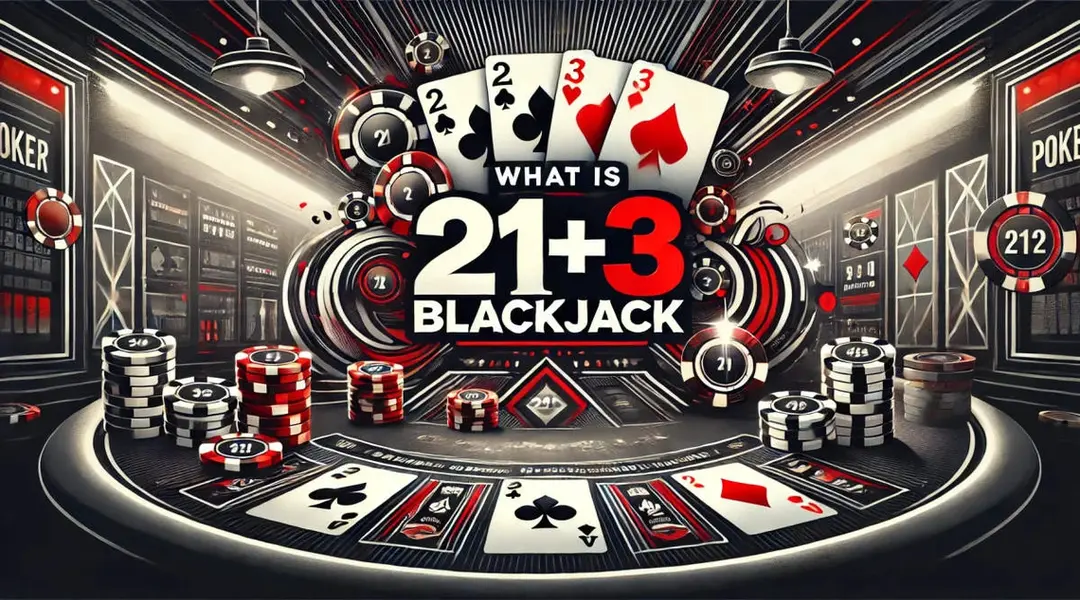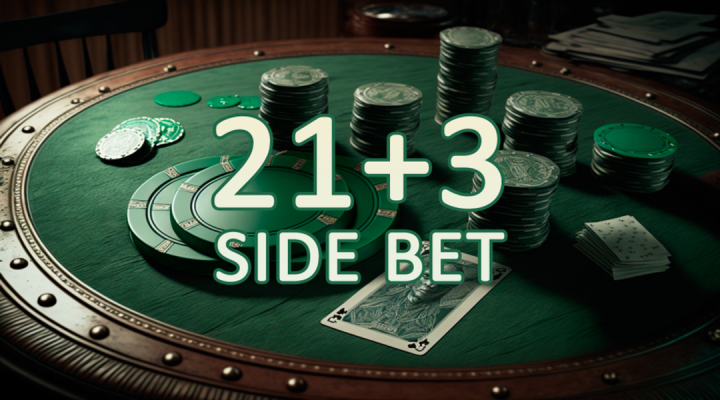21+3 Blackjack Meaning: Insights and Analysis

Blackjack has been a cornerstone of casino card games for decades, attracting players with its blend of skill, chance, and strategy. Over time, variations have emerged to add extra layers of excitement and complexity. One such variant is “21+3,” a side bet that brings a new dimension to the traditional game. In this review, we will delve into the meaning of 21+3 blackjack, exploring its mechanics, probabilities, and what makes it appealing to players. As a trusted guide, this analysis blends data, trends, and expert insights to provide a comprehensive understanding of 21+3 blackjack.
What is 21+3 Blackjack?
21+3 blackjack is a popular side wager in the traditional blackjack game that combines elements of poker with the standard card game. This side bet focuses on the player’s first two cards combined with the dealer’s upcard to form a three-card poker hand. The objective in this wager is to achieve a poker hand ranking that meets specific payout criteria, such as a flush, straight, three-of-a-kind, or straight flush.
The Meaning Behind 21+3 Blackjack
At its core, 21+3 blackjack offers a fusion of two popular card games. The term “21+3 blackjack meaning” refers to this addition of a three-card poker twist to the traditional blackjack format. Instead of only aiming to beat the dealer with a hand total closest to 21, players now have a secondary goal: creating a favorable three-card poker hand from the dealt cards. This not only heightens anticipation but also opens up additional strategies based on card combinations.
The popularity of the 21+3 side bet lies in its simplicity paired with an exciting twist. Even those who are not poker aficionados can appreciate the straightforward rules while still enjoying the enhanced stakes and increased engagement that the side wager brings.
The Appeal of the Side Bet
The 21+3 side bet is often embraced by players seeking an extra thrill. The novelty lies in its fusion of familiarity—classic blackjack rules—with the unpredictability of poker combinations. While the main game remains the same, the side bet provides an added layer of excitement. Studies suggest that a significant minority of players, perhaps up to 40%, opt to place the side bet at least occasionally due to its unique appeal.

A review of game trends shows that the odds for winning the 21+3 side bet can vary widely based on the specific combination. Although the house edge for side bets typically is higher than for the main blackjack game, many players are willing to take this small risk in exchange for the possibility of a big payout. Industry estimates indicate that the house edge for most 21+3 side bets ranges between 3% and 7%, depending on the payout structure and rules.
Analyzing the Gameplay and Strategy
The 21+3 blackjack side bet is straightforward in terms of participation: players place an additional wager alongside their standard bet. Once the cards are dealt, the side bet is resolved based on the best three-card poker hand formed by the player’s first two cards and the dealer’s upcard.
Understanding the three-card poker hand rankings is critical for grasping the side bet. The most common rankings relevant to 21+3 include:
- Straight Flush: Three consecutive cards of the same suit.
- Three of a Kind: All three cards of the same rank.
- Straight: Three consecutive cards of mixed suits.
- Flush: Three cards of the same suit, not in sequence.
These hand rankings determine the payout. Familiarizing oneself with these combinations and their respective probabilities can enhance overall gameplay.
Statistical Insights
The probability of forming a specific hand in a three-card combination varies. For instance, a straight flush is extremely rare, with odds approximating 0.22%. Three of a kind also occurs rarely, roughly 0.24% of the time. Straights appear around 3.26% of the time, while flushes are relatively more frequent, with a probability near 4.96%. These probabilities not only underline the excitement of landing high-ranking hands but also explain why the payouts for such hands are so lucrative. A straight flush might pay out at rates as high as 40:1 under certain rules, whereas a flush might only offer a 3:1 payout.
While placing the 21+3 side bet is largely based on chance, experienced players consider the ratio of potential payout to the side bet amount. It is generally recommended to treat the side bet as a fun addition rather than a core strategy due to its higher volatility. Observing payout structures across different tables can also be beneficial. Some tables adjust their payout tables, slightly increasing the odds for players. An informed player will pay attention to these variations to make the most of their wager.
In-Depth Look at 21+3 Blackjack Payouts
The term “21+3 blackjack payouts” refers to the range of rewards given based on the poker hand achieved. Understanding these payouts is central to appreciating the risk and reward dynamic in 21+3 blackjack. Let’s delve into how these payouts work and how they shape the overall gaming experience.
Though payout tables can vary, a typical structure might look like the table below:
| Hand Type | Payout Ratio |
|---|---|
| Straight Flush | 40:1 |
| Three of a Kind | 30:1 |
| Straight | 10:1 |
| Flush | 3:1 |
| Pair | 1:1 |
This table provides a simplified overview of potential returns. It’s essential to note that the actual payout percentages can differ based on specific game versions and house rules.
Impact on Game Dynamics
The allure of high payouts influences the number of players willing to place side bets. While the side bet inherently increases the overall risk, the promise of a significant payout is a compelling motivator. The table indicates that the most lucrative rewards are tied to rare events, further heightening the anticipation of gameplay. Players should approach the side bet with both enthusiasm and caution. Given that the higher payouts correspond to lower probabilities, the financial impact can be unpredictable. A sensible approach often involves wagering modest amounts on the side bet while keeping the primary focus on the main blackjack game.
Advantages and Limitations of 21+3 Blackjack
The benefits of adding the 21+3 side bet to the traditional game are numerous. It increases excitement, offers substantial winning potential, and introduces elements of poker that many players find enjoyable. However, the side bet also brings a higher house edge and increased variance, making it more volatile than the main game.
Players who seek to add a new twist to their gameplay should consider the statistical aspects of the side bet. For instance, while the chance of hitting a straight flush is low, the possibility of a huge payout makes the risk appealing. It is important to approach the side bet as a source of entertainment rather than a reliable method for consistent profit. If you’re interested in trying other strategy-based table games, check out Roulette77, a platform dedicated to roulette fans of all skill levels.
Best Practices for 21+3 Blackjack Enthusiasts
To get the most out of 21+3 blackjack, it’s crucial to combine knowledge with prudent bankroll management. Educating oneself on poker hand rankings and corresponding probabilities is a solid first step. Players should budget wisely, allocating only a small portion of their bankroll to the side bet. Monitoring payout structures across tables can identify more favorable conditions, and staying informed through ongoing research and community discussions ensures that strategies evolve with the game.
Using statistical analysis of past outcomes can help refine betting patterns and manage expectations. Given the higher variance of the 21+3 side bet, robust risk management strategies are essential to sustain enjoyment over time.
| Bet Type | House Edge (%) |
|---|---|
| Standard Blackjack | 0.5 – 1.5 |
| 21+3 Side Bet | 3 – 7 |
| Insurance | 7 – 8 |
| Pair Splits | 2 – 5 |
This comparative table highlights the relative house edge of various bets within a blackjack game, illustrating how the 21+3 side bet fits into the overall risk landscape.
What Does the Future Hold for 21+3 Blackjack?
Given the evolving nature of casino games, 21+3 blackjack is likely to remain popular among enthusiasts who enjoy its blend of skill and luck. Its continued success hinges on a few factors: rule innovation, technological integration, and community engagement. Game developers may introduce variations with adjusted payout structures or additional side bets to keep the game fresh. As online casinos become more sophisticated with algorithms and data analytics, players might see more nuanced probability approaches and strategy recommendations tailored to 21+3 blackjack.
Community forums and online discussions play a significant role in sharing experiences, strategies, and statistical insights. Such collective knowledge ensures that both new and seasoned players continue to adapt and refine their play styles. Data-driven decision making is becoming more common in blackjack circles, and this trend is likely to influence how players approach side bets like 21+3.
Conclusion
The 21+3 blackjack variant adds an intriguing layer of complexity to the traditional game, enriching the player experience with a side bet that combines the fundamentals of blackjack with poker hand rankings. Through this review, we have unpacked the 21+3 blackjack meaning, examined how the side bet works, and explored its payouts, probabilities, and strategic dimensions.
While the appeal of potentially high rewards is undeniable, players must balance enthusiasm with prudent bankroll management, given the higher house edge and variance associated with the side bet. By understanding the statistics and strategies, enthusiasts can make educated decisions, enhancing both their enjoyment and potential success at the tables.
For those ready to explore beyond the basics, 21+3 blackjack offers an opportunity to immerse themselves in a world where every hand holds the promise of excitement, strategic nuance, and the thrill of achieving a rare, high-paying poker combination without compromising the integrity of traditional blackjack.